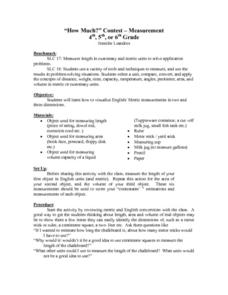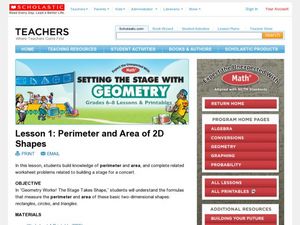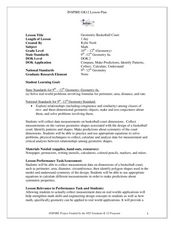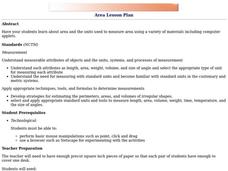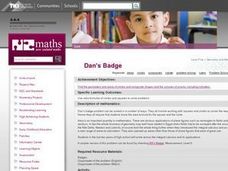Curated OER
"How Much?" Contest - Measurement
Students work with measurements of length, area, and volume capacity of a liquid. They watch a teacher demonstration of both English and metric units before they estimate and take actual measurements of assigned items a three different...
Curated OER
Measuring with Mathematics
Eighth graders discover how the change in the dimensions of a shape cause a change in the overall area of the shape, but the perimeter stay the same. They, in groups, go out to the playground and construct large areas using stakes and rope.
Teachers Network
A World of Symmetry: Math-Geometry
Define and identify the three basic forms of symmetry translation, rotation, and glides with your class. They cut out and arrange paper pattern blocks to illustrate symmetry, create a Cartesian graph, and design a rug with a symmetrical...
Curated OER
Perimeter and Area of Similar Figures
Students explore the relationships between similar figures. In this relationships between similar figures lesson, students discuss relationships between perimeter, circumference, area, surface area, and volume of similar figures through...
Curated OER
Perimeter and Area of 2D Shapes
Students find the perimeter and area of circles, triangles, and rectangles. In this perimeter and area lesson plan, the teacher gives students formulas for each shape and measurement and works through examples on the board. While no...
Curated OER
Can We Measure the Impossible?
In this measurement worksheet, learners explore methods to measure the thickness of foil. They write an essay on how they calculated the thickness of the foil, and the number of atoms thick it is. Students create labeled sketches to...
Curated OER
The Greedy Triangle
Third graders use the book "The Greedy Triangle" to practice measuring perimeter and area. They also calculate the length of objects.
Curated OER
Shape Matters More!
Students investigate shapes as the area changes while the perimeter remains the same. Students demonstrate the shape/perimeter/area relationship using simulations and physical models.
Curated OER
Geometric Basketball Court
Learners calculate the area and perimeter of a basketball court. In this geometry lesson, students differentiate between similarity and congruence of geometric objects. They test conjectures and use it to solve problems.
Curated OER
Measurement, Perimeter and Area
Students explore the concept of measurement. In this measurement lesson, students collect data about themselves such as height, finger length, neck circumference, foot length, and other body measurements. Students cut squares...
Curated OER
Rep Tiles
Third graders use pattern blocks of one shape at a time to try to create a similar shape. They compare the perimeter of the new figure with the perimeter of the original shape and look for a pattern. Students use the pattern to predict...
Curated OER
Pythagorean Theorem
Students are introduced to the Pythagorean theorem. They use three different activities that give students the opportuntiy to observe triangles, and use the Pythagorean theorem and practice different ways of determining areas of...
Curated OER
Picket Fence Around the Garden
Students design different shaped plots and determine the perimeter, area and shape of each. They compare the shapes that have the same area but may have different perimeters.
Curated OER
Volume & Candy Creations Model
Sixth graders investigate surface area. In this surface area lesson, 6th graders design a box of candy that has a volume of 30 cubic inches. Students are trying to minimize surface area while keeping volume constant. ...
Curated OER
Measuring to the Nearest Inch
Third graders use whole numbers and fractions to make connections between abstractions of the mathematical world and the real world. In this fractions and measurement activity, 3rd graders identify, quantify groups , and measure...
Curated OER
Area Lesson Plan
Learners explore geometry by using computer applications. For this spatial measurement lesson, students discuss the difference between area, weight, volume and other forms of measurement. Learners utilize computer applications to find...
Curated OER
Dan's Badge
Students solve a math problem using area formulas of circles and squares. They read and discuss the problem, analyze images of badges, reconstruct the badge from the problem using circles and rulers, and share the solution with the class.
Curated OER
"it's All in the Cellar"
Seventh graders examine the process of constructing a site plan map at archaeological sites. They discuss the process of mapping techniques and calculation of percentages, create a plan site map of a cellar at Jamestown, and calculate...
Curated OER
NON-EUCLIDEAN GEOMETRY.
Young scholars study relationships between angles, side lengths, perimeters, areas and volumes of similar objects. In this lesson students also create and critique inductive and deductive arguments concerning congruency, similarity and...
Curated OER
Measure Me!
Third graders use nonstandard concrete methods to estimate and record measurements of their body.
Curated OER
Polygonal Strings
Sixth graders apply knowledge of how to calculate the area and perimeter of triangles. They determine why it is inappropriate to measure the area of land by its perimeter which is done in certain areas of New Guinea. They complete a...
Curated OER
Peter's Second String
Fifth graders determine the maximum area and range of areas of a rectangle with a given perimeter. They discuss a word problem involving perimeter and area as a class, investigate the word problem using a piece of string, and in small...
Curated OER
Grade 3: What Can I Make with 30 Centimeters?
Third graders create polygons with perimeters of 30 centimeters, use the centimeter grid paper to determine the area of each shape, and organize the shapes to make generalizations from the patterns they see.
Curated OER
NetsS.A. of Prisms
Students build nets of three-dimensional prisms based on the dimensions they are given for hexagonal prism, triangular prism, rectangular prism. Working in groups, they use their prisms and calculate the Surface Area and Lateral Area.
